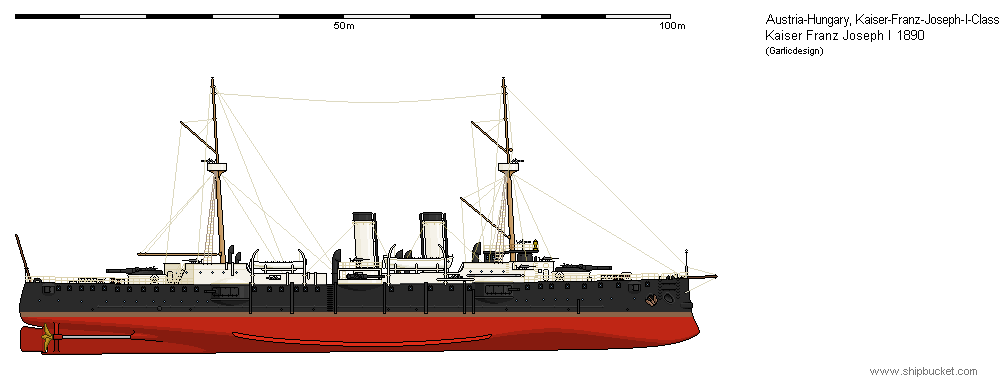Some Austrian cruisers
Posted: September 30th, 2020, 9:03 pm
Hi all!
Austria's only pair of second class protected cruisers: SMS Kaiser Franz Joseph I and Kaiserin Elisabeth.
They were ordered as an answer to Italy's Elswick-type cruisers Giovanni Bausan and her home-grown successors. They carried two 240mm guns in barbettes fore and aft, theoretically enabling them to engage older ironclad battleships from safe distance (as the Japanese did at the Yalu in 1894); secondary armament were six 150mm guns and fifteen (Elisabeth only thirteen) 47mm guns (best guess based upon photographic evidence; written sources vary between nine and 16 47mm). They were good steamers capable of 20 knots, which was a good figure in 1890, and their built-up superstructure made them quite habitable. The paintjob apparently changed frequently; I've found photographs with white, black and (probably) buff funnels, and with black and buff or brown (the latter colour is shown on contemporary paintings of Austrian warships) funnels.

Both spent about half their careers in the far east, when they were painted white with brown (or buff, see above) masts.

After 1900, they were refitted. They landed their 240mm guns in favour of two more 150mm guns; Elisabeth's were placed behind gunshields in the old 240mm barbettes, while Franz Joseph's were mounted in single turrets. Now their light armament was unified with 16 47mm guns. They also received a wireless rig.

Elisabeth was in Tsingtau in 1914 and had to be scuttled when the Japanese took over. Franz Joseph spent the war as an auxiliary and was ceded to the Allies in 1918; before she could be handed over, she sank in a storm.

Greetings
GD
Austria's only pair of second class protected cruisers: SMS Kaiser Franz Joseph I and Kaiserin Elisabeth.
They were ordered as an answer to Italy's Elswick-type cruisers Giovanni Bausan and her home-grown successors. They carried two 240mm guns in barbettes fore and aft, theoretically enabling them to engage older ironclad battleships from safe distance (as the Japanese did at the Yalu in 1894); secondary armament were six 150mm guns and fifteen (Elisabeth only thirteen) 47mm guns (best guess based upon photographic evidence; written sources vary between nine and 16 47mm). They were good steamers capable of 20 knots, which was a good figure in 1890, and their built-up superstructure made them quite habitable. The paintjob apparently changed frequently; I've found photographs with white, black and (probably) buff funnels, and with black and buff or brown (the latter colour is shown on contemporary paintings of Austrian warships) funnels.
Both spent about half their careers in the far east, when they were painted white with brown (or buff, see above) masts.
After 1900, they were refitted. They landed their 240mm guns in favour of two more 150mm guns; Elisabeth's were placed behind gunshields in the old 240mm barbettes, while Franz Joseph's were mounted in single turrets. Now their light armament was unified with 16 47mm guns. They also received a wireless rig.
Elisabeth was in Tsingtau in 1914 and had to be scuttled when the Japanese took over. Franz Joseph spent the war as an auxiliary and was ceded to the Allies in 1918; before she could be handed over, she sank in a storm.
Greetings
GD